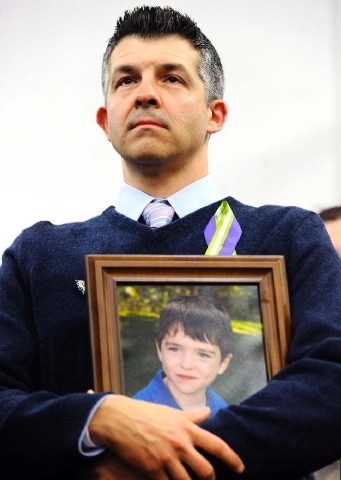Another ordeal for Newtown: Divvying up donations
HARTFORD, Conn.— More than six months after losing loved ones in the shooting at Sandy Hook Elementary School, families say dealing with questions over how to distribute the millions of dollars sent to help Newtown heal is instead causing them more pain.
How much should go to the families of the slain children and educators? To the families of the children who witnessed the massacre but survived and will need to pay for years of therapy? To the slain staff members’ families, who may have lost a breadwinner? Or to the Newtown community at large? And who gets to make those decisions?
The largest Newtown charity had planned an initial distribution of less than half of its money to victims’ families, who raised questions about how the fund arrived at the number. The place they were then given in the process has been difficult, unpleasant and something they shouldn’t have had to worry about on top of their grief, families say.
So some families are joining in the idea for a national victims’ “compassion fund” along with relatives left behind after other shootings such as those at Virginia Tech, a Sikh temple in Wisconsin and a movie theater in Aurora, Colo. Under the proposal, money donated after future tragedies would be sent directly to those most affected, cutting out major nonprofits that are set up to be more focused on the community.
“Nobody who has been through this wants to have to go and deal with boards and committees and talk about money, and justify why you need it,” said Cristina Hassinger, the daughter of slain Sandy Hook Elementary School principal Dawn Hochsprung. “Money is the last thing you want to have to deal with, especially when you are grieving.”
The gunman at Sandy Hook killed 20 first-graders and six educators, all women, on Dec. 14. Two wounded staff members survived, as did 12 children who saw the shootings. Donations after the shocking massacre of such young children poured in from all over the world.
Distributions from the biggest charitable fund, the Newtown-Sandy Hook Community Foundation, have been delayed twice as administrators try to balance the needs of the recipients. The fund, formed to take control of $11.4 million that was raised with the help of the United Way, has said it plans to divvy up $7.7 million among the families of the children killed, to the surviving children and the two staffers.
Committees will be formed and meetings held to decide how to spend the rest of the money, and whether to keep some of it as an investment tool for future mental health care and other needs.
Reaching a consensus over the split has not been easy, especially when trying to bring together families that have been through so much but may have competing interests, said Dr. Charles Herrick, the foundation’s president.
“Whenever you see a child who survived that situation, it is going to be all the more painful, magnifying your own sense of loss,” he said. “Alternatively, if your child was exposed to that horror, your concern is how do I protect my child? How do I help my child overcome these terrible memories and get on with their lives without this forever damaging them? So, the needs are very different.”
The families are not seeking more money and the issue is much bigger than just deciding how much each deserves, said Ian Hockley, whose 6-year-old son, Dylan, was killed at Sandy Hook. The state attorney general has identified more than 70 funds in Newtown that have raised more than $21 million for everything from a memorial to scholarships for Sandy Hook students.
The hodgepodge of charities has created a cumbersome process for everyone involved, and a concern that some people may be using the images of slaughtered children inappropriately.
“What’s the objective here?” Hockley said. “The objective is to heal Newtown and to take care of its most affected people. And if all of that money is there for that purpose, then this has to be looked at as a whole.”
He is among the Newtown relatives endorsing the different approach for collecting donations after such tragedies — one that they say could have made it easier on them by clarifying from the outset that certain funds are reserved for victims and others for the broader community. They and families affected by other shootings have taken the idea for a compassion fund to the National Center for Victims of Crime.
“Public intent is to help the victims directly,” said Anita Busch, whose cousin, Micayla Medek, 23, died in the Aurora movie theater. “The right thing to do is to give the victims what was collected in the names and stories and faces of their murdered and injured loved ones.”
The national compassion fund could be ready within a few months, the crime victims center said. The group is now setting up protocols for disbursement.
“They came for us looking for much more transparency and a clearer solution, not only for the victims, but for the donors,” spokeswoman Kath Cummins said. “It should be clear when you donate where your money is going. We want a website that can be up and running and people will know this is a fund that is going directly to the victims.”
The group is following the example of The One Fund, set up in Massachusetts after the Boston Marathon bombing to help the injured and the families of the three people killed.
“Boston showed it can really work and money can go directly to victims,” she said. “But this is new for everyone, so we’re proceeding cautiously.”
Only one fund in Connecticut, the My Sandy Hook Family Fund, was set up to give money directly to victims’ families. It has distributed all of the $1.5 million it has received equally among the 26 families who lost loved ones, said Rob Accomando, a Sandy Hook resident administering the fund.
Last month, Connecticut’s General Assembly created CT CARE, a quasi-public foundation designed to streamline the handing of donations. The foundation would create a central place for donors to send money in response to a tragedy, and a distribution committee, with representatives from the affected community, would dole out the money to victims and other charities.
“CT CARE will serve as a trusted repository for private donations — an entity that will disseminate those funds to the victims in accordance with the intent of the donors,” Gov. Dannel P. Malloy said in a statement.
The problems of distribution, even from one fund, are seen most acutely in the troubles of the Newtown-Sandy Hook Community Foundation.
The victims’ share of the main fund was increased from $4.4 million after a number of the families raised concerns over how the figure was reached, and the distribution was delayed a second time when victims’ relatives went to state Attorney General George Jepsen, seeking his help in finding out how the distribution decisions were being made and by whom.
At Jepsen’s urging, the foundation’s three-member distribution committee, led by retired U.S. District Court Judge Alan Nevas, agreed to meet July 11 and 12 with each family individually to assess their needs. It will also hold a public hearing on July 11 on the disbursement plan, Nevas said.
“Everybody will not be equal,” Nevas said. “The 26 people who lost their lives will not be treated the same as the 14 people who survived.”


















